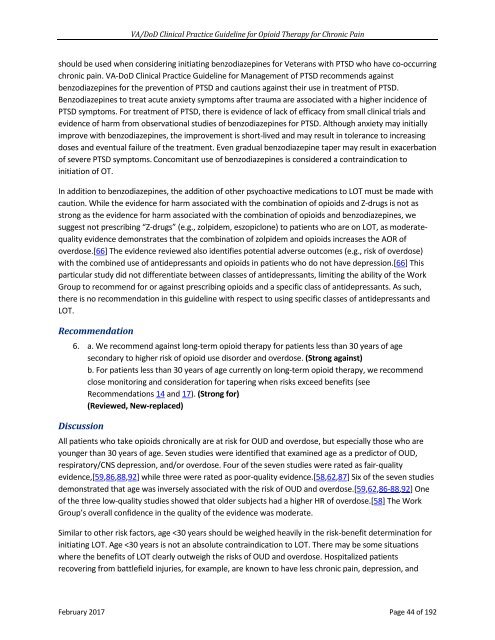VA/DoD CLINICAL PRACTICE GUIDELINE FOR OPIOID THERAPY FOR CHRONIC PAIN
2lfFhbO
2lfFhbO
Create successful ePaper yourself
Turn your PDF publications into a flip-book with our unique Google optimized e-Paper software.
<strong>VA</strong>/<strong>DoD</strong> Clinical Practice Guideline for Opioid Therapy for Chronic Pain<br />
should be used when considering initiating benzodiazepines for Veterans with PTSD who have co-occurring<br />
chronic pain. <strong>VA</strong>-<strong>DoD</strong> Clinical Practice Guideline for Management of PTSD recommends against<br />
benzodiazepines for the prevention of PTSD and cautions against their use in treatment of PTSD.<br />
Benzodiazepines to treat acute anxiety symptoms after trauma are associated with a higher incidence of<br />
PTSD symptoms. For treatment of PTSD, there is evidence of lack of efficacy from small clinical trials and<br />
evidence of harm from observational studies of benzodiazepines for PTSD. Although anxiety may initially<br />
improve with benzodiazepines, the improvement is short-lived and may result in tolerance to increasing<br />
doses and eventual failure of the treatment. Even gradual benzodiazepine taper may result in exacerbation<br />
of severe PTSD symptoms. Concomitant use of benzodiazepines is considered a contraindication to<br />
initiation of OT.<br />
In addition to benzodiazepines, the addition of other psychoactive medications to LOT must be made with<br />
caution. While the evidence for harm associated with the combination of opioids and Z-drugs is not as<br />
strong as the evidence for harm associated with the combination of opioids and benzodiazepines, we<br />
suggest not prescribing “Z-drugs” (e.g., zolpidem, eszopiclone) to patients who are on LOT, as moderatequality<br />
evidence demonstrates that the combination of zolpidem and opioids increases the AOR of<br />
overdose.[66] The evidence reviewed also identifies potential adverse outcomes (e.g., risk of overdose)<br />
with the combined use of antidepressants and opioids in patients who do not have depression.[66] This<br />
particular study did not differentiate between classes of antidepressants, limiting the ability of the Work<br />
Group to recommend for or against prescribing opioids and a specific class of antidepressants. As such,<br />
there is no recommendation in this guideline with respect to using specific classes of antidepressants and<br />
LOT.<br />
Recommendation<br />
6. a. We recommend against long-term opioid therapy for patients less than 30 years of age<br />
secondary to higher risk of opioid use disorder and overdose. (Strong against)<br />
b. For patients less than 30 years of age currently on long-term opioid therapy, we recommend<br />
close monitoring and consideration for tapering when risks exceed benefits (see<br />
Recommendations 14 and 17). (Strong for)<br />
(Reviewed, New-replaced)<br />
Discussion<br />
All patients who take opioids chronically are at risk for OUD and overdose, but especially those who are<br />
younger than 30 years of age. Seven studies were identified that examined age as a predictor of OUD,<br />
respiratory/CNS depression, and/or overdose. Four of the seven studies were rated as fair-quality<br />
evidence,[59,86,88,92] while three were rated as poor-quality evidence.[58,62,87] Six of the seven studies<br />
demonstrated that age was inversely associated with the risk of OUD and overdose.[59,62,86-88,92] One<br />
of the three low-quality studies showed that older subjects had a higher HR of overdose.[58] The Work<br />
Group’s overall confidence in the quality of the evidence was moderate.<br />
Similar to other risk factors, age


